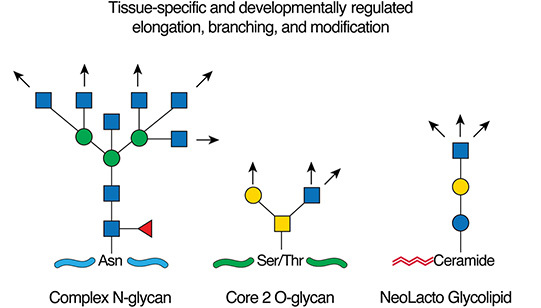From: Chapter 14, Structures Common to Different Glycans

PDF files are not available for download.
NCBI Bookshelf. A service of the National Library of Medicine, National Institutes of Health.

N-Glycan synthesis (Chapter 9) leads to complex N-glycans with branching GlcNAc residues that are generally extended (arrows) in glycosylation reactions that may be tissue-specific, developmentally regulated, or even protein-specific. The GlcNAc linked to the core mannose is termed the bisecting GlcNAc, and it is not usually modified. O-GalNAc glycan synthesis (Chapter 10) includes a core 2 structure with GlcNAc that may be modified subsequently by many of the same enzymes that act on N-glycans. Glycolipid core structures (Chapter 11) and O-fucose and O-mannose glycans (Chapter 13) with a terminal GlcNAc are also modified by many of the same enzymes that act on N- and O-glycans.
Download Teaching Slide (PPTX, 1.7M)
From: Chapter 14, Structures Common to Different Glycans

PDF files are not available for download.
NCBI Bookshelf. A service of the National Library of Medicine, National Institutes of Health.